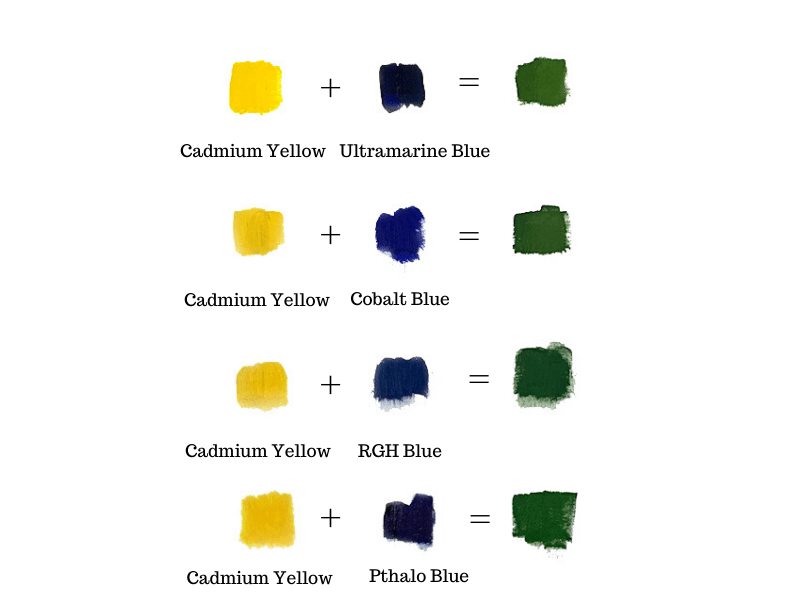Do you ever stare at a rainbow and wonder how those vibrant colors come together to create the stunning shades we see in nature? Or perhaps you’ve stood before a painting, mesmerized by the way a talented artist uses a single color to evoke a whole range of emotions. The truth is, the secret lies in the magic of primary colors, the building blocks of all other hues we know and love. Today, we’re diving into the heart of color theory, exploring the simple yet powerful technique of mixing primary colors to create the ever-versatile green, a color that symbolizes life, growth, and harmony.

Image: www.pinterest.ph
Whether you’re a seasoned artist, a curious child exploring the world of color, or simply someone who enjoys the beauty of hues, learning how to create green with primary colors opens a door to a world of artistic possibilities. From painting masterpieces to understanding the science behind our perception of color, this journey will equip you with the knowledge to unleash your inner artist and understand the fundamental principles of color mixing.
The Building Blocks of Color: Primary Colors
Imagine a world devoid of color. It would be a stark and dreary place, lacking the vibrancy and excitement that hues bring to our lives. Fortunately, we live in a world bursting with color, and it all begins with the three primary colors: red, yellow, and blue. These are the fundamental building blocks of color, the purest forms that cannot be created by mixing any other hues.
Think of them as the base ingredients in a culinary world, the primary colors create an infinite spectrum of possibilities when combined.
Creating Green: A Symphony of Primary Colors
One of the most beautiful and intriguing colors that emerges from mixing primary colors is green. It’s a color that evokes feelings of tranquility, renewal, and growth. To achieve this remarkable shade, we embark on a simple yet fascinating process, mixing the primary colors of blue and yellow.
The ratio of these two primary colors determines the final shade of green. For example, mixing equal parts of blue and yellow yields a vibrant, true green. However, if you want a more yellow-toned green, add more yellow, while a more blue-toned green will result from adding more blue.
Understanding the Science of Color Mixing
The mixing of primary colors leads to secondary and tertiary colors. Secondary colors are created by combining two primary colors, while tertiary colors are formed by mixing a primary and a secondary color. Green, the beautiful and versatile color we’re exploring, is a secondary color, resulting from the marriage of blue and yellow.

Image: besettled.org
Beyond the Basics: Exploring Shades of Green
Mixing primary colors for green is just the beginning of a journey into a world of endless possibilities. The beauty of color mixing lies in its ability to generate an array of intricate shades from a simple combination of primary colors. To create a richer palette of green, artists often add a touch of black or white to their base mix, achieving darker or lighter shades. Adding a bit of brown can also create earthy greens, reminiscent of the natural world.
Experimenting with Your Own Color Creations
Now that you understand the basic principles of creating green with primary colors, it’s time to unleash your artistic potential and experiment with color exploration. Gather your paints, watercolors, or even crayons, and explore the different shades and hues you can achieve by varying the proportions of blue and yellow.
Begin by mixing equal parts of each color to create a vibrant, true green. Then, explore the spectrum by adding more blue for a cooler, more blue-toned green, or more yellow for a warm, yellow-toned green. Don’t be afraid to get your hands dirty. This is the joy of experimenting and finding your unique artistic expression.
Expert Insights & Actionable Tips:
To truly master the art of creating green with primary colors, consider these expert tips:
- Start with a Quality Palette: Investing in high-quality paints or watercolors ensures vibrant and beautiful results, allowing you to blend colors seamlessly and create a stunning range of shades.
- Experiment with Different Paint Brands: Each brand has its unique color formula, resulting in distinctive shades of green. Try different brands and observe the differences, expanding your understanding of color.
- Observe Nature’s Masterpieces: Nature is the ultimate source of inspiration for artists. Observe the various shades of green in leaves, grass, and vegetation. These will serve as inspirations for your own creations.
How To Make Green With Primary Colors
https://youtube.com/watch?v=1uOEhL-WjG4
Conclusion: A Legacy of Color
Through understanding and mastering the art of mixing primary colors to create green, you’ve embarked on a journey of artistic expression, a journey that stretches back centuries. From ancient cave paintings to modern masterpieces, the power of color has played a crucial role in human creativity. By learning how to create the captivating spectrum of green, you’ve added a new dimension to your artistic toolkit, expanding your ability to unleash your imagination and evoke a world of emotions through the magic of color. Now that you’ve embraced the world of green, continue your artistic exploration, dive into the world of color theory, and discover a universe of hues waiting to be unleashed, one stroke at a time.






